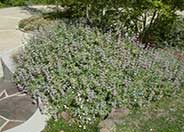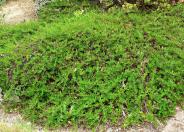
Common name:Moonshine Yarrow, Milfoil, Sneezewo
Botanical name:Achillea 'Moonshine'
Long, straight stems with pale yellow flowers are striking on the mats of green to grey-green leaves of this plant, which are flatter and less divided than those of the Achillea millefolium. This Yarrow propagates easily from rooted cuttings or divisions which should be performed in the early spring or fall. Following bloom, one should dead head the plant and divide the clumps when it appears crowded. Introduced by Alan Bloom in the 1950's.

Common name:Myers Asparagus
Botanical name:Asparagus densiflorus 'Myers'
An evergreen groundcover, the 'Meyers' also makes an excellent hanging basket when larger in size. Its formal looking fronds have an even, spiral arrangement of leaflets. It is damaged by severe frosts, and looks best with at least occasional watering.
-Monterey Bay Nursery

Common name:Point Sal Spreader Sage
Botanical name:Salvia leucophylla 'Point Sal Spreader'
The Point Sal Spreader Sage is an evergreen shrub that grows 3'-4' tall and 4'-6' wide. It has gray green to white leaves. Flowers are pinkish purple. This shrub tolerates heat and droughts. This Salvia is a California native. This variety has a more prostrate form than other varieties.

Common name:Catmint
Botanical name:Nepeta X faassenii
Nepeta faassenii makes soft, grey-green, undulating mounds to 1' tall in bloom, spreading 3'-4' wide. The small leaves are attractive to cats. This perennial has lavender blue flowers in summer. Catmint can be planted in sun or shade and needs medium amount of water. Prune spent flowers to encourage more blooms.

Common name:Hearst's Ceanothus, Hearst Ranch Bu
Botanical name:Ceanothus hearstiorum
This Ceanothus is endemic to California, where it grows wild only on the hilly coastline of San Luis Obispo County. This shrub is generally wider than it is tall and often lies prostrate in a mat on the ground. The younger branches are hairy and somewhat feltlike in texture. The distinctive evergreen leaves are oval to almost rectangular and have a cupped, rippled surface. The edges are toothed with tiny hairy knobs and the shiny surface may be dotted with more knobs. The underside of the leaf is fuzzy to hairy. The flower clusters are borne on short, stout stalks and the tiny flowers are lavender to blue with prominent yellow-anthered blue stamens. This plant prefers to be near the coast where it would have cooler temperatures and some fog. If planted inland, give afternoon shade and an occasional rinse in the summer. It is a rare plant in the wild due to its extremely limited distribution. However, it is a popular garden plant and is readily available at nurseries.
Designer:
Photographer: Vicki Anderson
Practice grass-cycling by leaving short grass clippings on lawns after mowing, so that nutrients and organic matter are returned to the soil.
Develop healthy soil for plants that are vigorous and naturally pest-resistant.